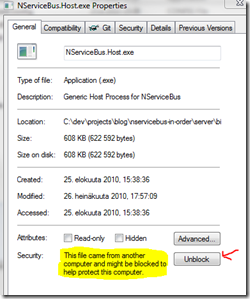NServiceBus Weekly: #1
Welcome to the first ever NServiceBus Weekly. As the name suggests, these posts will concentrate on the latest happenings around the NServiceBus. New post is released once a week, every Wednesday.
There’s going to be few different sections:
- News: News and upcoming courses.
- Tutorials and Articles: Blog posts, e-books and Code Project-articles.
- Community: Interesting questions from StackOverflow, hottest topic from NServiceBus Yahoo! Group and sample applications from the GitHub.
Every section will concentrate on NServiceBus. Also, any feedback is greatly appreciated. Please let me know if I missed an interesting link.
Because this is the first NServiceBus Weekly, we have an extra section: NServiceBus. This section will contain links to articles and web pages which will give you a good introduction on this popular open source service bus for .NET Framework, founded by Udi Dahan.. Also this week’s NServiceBus Weekly will contain links which are older than one week. Starting from the next post, I will concentrate on the latest happenings.
NServiceBus
- NServiceBus homepage – This is the home of NServiceBus. It contains documentation, download links and license information. Start from here.
- NServiceBus official documentation – Unlike some other open source projects, NServiceBus actually has a pretty good documentation. The FAQ on there front page will get you started quickly.
- NServiceBus source code – Even though GitHub isn’t the official place for NServiceBus source code, it’s the easies way to get the latest codes.
- NServceBus samples – NServiceBus source code contains a large number of sample applications. Pub/sub, logging, ASP.NET communication, WCF integration and so on, they all are covered in the sample applications.
- NServiceBus discussion board – NServiceBus Yahoo! group is the main source of NServiceBus related discussions. You can use Yahoo’s own web page or Grouply to follow the discussion.
- Enterprise service bus – NServiceBus is an enterprise service bus. This Wikipedia article will give you a good introduction on the topic.
News
- "Still OSS, but higher value offerings not free in binary form." – NServiceBus has taken the next step: It now offers a commercial option. The NServiceBus source code will continue to be open and anybody can still fork the code. The commercial version will offer more features like distributor, gateway and saga timeout management. This change was made “In order to save #NServiceBus from the same fate as other OSS projects (victims of their success)”. The current 2.0 version will remain completely free. The next service pack of 2.0 version will be called 2.5.
- NServiceBus License Packages – If you’re interested in the features provided by the commercial licenses, this page will give you all the details.
- NServiceBus Developer Studio – Not much is known about the up-coming NServiceBus Developer Studio. Currently it seems that it will be a commercial application and it will allow the developers to visualize what is happening inside the NServiceBus. More news to follow, I’m sure.
Tutorials and Articles
- Experimenting with enterprise level bus messaging – Sacha Barber takes a look into NServiceBus. Includes a demo application with a WPF client.
- Enterprise Service Bus Messaging Using nServiceBus – Little older link (04/2008) but still a good tutorial on NServiceBus.
- Udi Dahan on CQRS, DDD and NServiceBus – Excellent interview of Udi Dahan by InfoQ. Covers the aspects of CQRS and DDD in addition to NServiceBus.
- Building enterprise applications with NServiceBus - Andreas Öhlund’s presentation from this year’s ALT.NET. Easy to follow introduction on NServiceBus. Covers the mechanisms like pub/sub and generic host.
- NServiceBus: In-order message processing – Tutorial by Mikael Koskinen on how to process messages in order with NServiceBus.
- Getting Started with NServiceBus Part 3: Putting Messages on the Bus – Adam Fyles’ latest NServiceBus related blog post where he continues to explore on how the ASP.NET MVC Music Store can benefit from NServiceBus.
Community
- NServiceBus. Testing .net 4-0 build – This Priyank’s post led to some fixes which allows one to use the NServiceBus.Testing with .NET Framework 4.0.
- Using Fluent Config to set the input queue – From these posts you can learn how to set the input queue progmatically. But please keep in mind that this isn’t the recommended approach.
- nservicebus message serialization – In his answer, David reminds us about the Bus.CurrentMessageContext.
- NServiceBus: Aren’t MSMQ Transactions BAD – Good question from skbwith two good answers. Offers advices on how NServiceBus uses the features provided by MSMQ.
- NServiceBus-Contrib – New contribution project for NServiceBus. Still empty but hopefully will contain many contributions for the NServiceBus in the near future.
Here’s also an list of blogs which have been active lately and have posts related to NServiceBus. Please let me know if I missed something.
- Udi Dahan’s blog – Udi Dahan is the person behind NServiceBus. His blog covers all the the aspects of software architecture.
- Andreas Öhlund’s blog – Andread Öhlund is one of the most active members of NServiceBus community. His blog contains many good NServiceBus related posts.
- Mikael Henrikkson’s Conquering NServiceBus – Getting started guide by Mikael Henrikkson. Contains good information about NServiceBus configuration, sagas and testing.
- Adam Fyles’ blog – Good Getting Started Guide on NServiceBus. Well worth reading.
- Mogens Heller Grabe's (mookid's) blog - Contains a good getting started guide ("NServiceBus for dummies who want to be smarties") with advanced topics like sagas. Recommended reading for everyone.
- Mikael Koskinen’s blog – That’s me.




